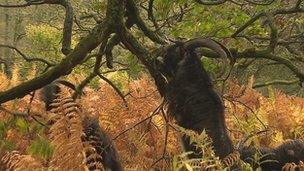Concern as Inversnaid feral goat cull resumes
- Published
Feral goats on the banks of Loch Lomond are popular with tourists
RSPB Scotland has resumed a controversial cull of feral goats on the eastern shore of Loch Lomond.
The environmental organisation is facing criticism from local people, who fear the cull could wipe out the entire population of goats around Inversnaid.
The animals are popular with tourists and walkers on the West Highland Way.
But their voracious appetites cause problems for conservationists and RSPB Scotland says it needs to protect the rich woodland habitat.
It wants to reduce goat numbers in the Inversnaid area from about 69 to 30 in the coming years.

The goats have a voracious appetite for the woodland habitat
Reserves manager Robert Coleman said: "This is Scotland's rainforest. We've got a huge range of moss and lichen here. In fact, 5% of all of the world's moss species are represented in Scotland and this habitat is an excellent example of that diversity.
"By managing the herbivores, deer and goats, we can ensure the longevity of this habitat and make sure there are trees, mosses and lichens in the future while ensuring we maintain the populations of herbivores within the area as well."
Twenty goats are due to be shot this year. The local community council and the British Feral Goat Research Group believe the remaining population may be too small to survive a series of harsh winters.
Community councillor Andre Goulancourt told BBC Scotland: "If the goats were at a low number and we had two or three successive bad winters then we would end up with no goats.
"These goats have been here for a long time and they represent an asset to the tourist industry that Inversnaid depends on. The local people enjoy seeing them too and it would be a great loss if the goats were to disappear."
'Important elements'
But Scottish Natural Heritage has backed the cull.
Alan McDonnell, of SNH, said: "A recent survey found that goat numbers are higher than previously thought, and the cull is necessary to bring numbers down to a more sustainable level. Pollochro Woods is a protected natural site and part of the Loch Lomond Woods Special Area of Conservation.
"The protected features in these woods include the native woodland habitat itself, mosses and lichens -- which are all threatened and important elements of Scotland's nature."
Meanwhile, Forestry Commission Scotland has pledged to consult with the local community on plans to reduce goat numbers in the wider area.
A spokesman said: "There is a real need to balance the long-term restoration and management of Loch Katrine, Loch Ard and surrounding areas with the increasing numbers of feral goats.
"Managing the feral goat population also reduces the risk of them becoming a hazard for road users in the area. This is done in consultation with the local communities so that we can fully explain what we are doing and why."